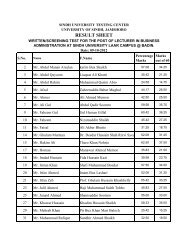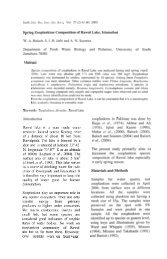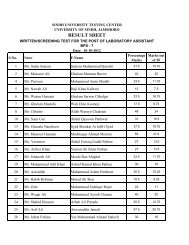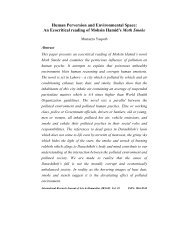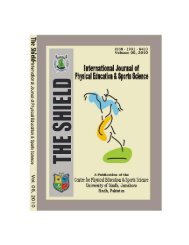Download - University of Sindh
Download - University of Sindh
Download - University of Sindh
You also want an ePaper? Increase the reach of your titles
YUMPU automatically turns print PDFs into web optimized ePapers that Google loves.
<strong>Sindh</strong> Univ. Res. Jour. (Sci. Ser.) Vol.44 (1) 85-90 (2012)<br />
SINDH UNIVERSITY RESEARCH JOURNAL (SCIENCE SERIES)<br />
Computerized Scrabble Word Game in National and Regional Languages <strong>of</strong> Pakistan<br />
A.A. SHAH, L.D. DHOMEJA, I. A. ISMAILI AND A. I. AMJAD<br />
Institute <strong>of</strong> Information and communication technology, <strong>University</strong> <strong>of</strong> <strong>Sindh</strong>, Pakistan<br />
*Corresponding author: e.mail: azhar.shah,lachhman,imdad.ismaili)@usindh.edu.pk. Cell.No.03223077286<br />
1. INTRODUCTION<br />
Information and communication<br />
technology (ICT) have long been used to aid and<br />
enhance the learning skills at almost every level <strong>of</strong><br />
education. The integration <strong>of</strong> ICT with the<br />
mainstream education has been going under the<br />
headings <strong>of</strong> ‘edutainment’ and ‘play-and-learn’. The<br />
integration <strong>of</strong> play and learning is usually achieved by<br />
means <strong>of</strong> developing computerized educational<br />
games. Scrabble is one <strong>of</strong> these educational games<br />
that have become much popular around the world.<br />
Besides providing the fun, Scrabble also helps the<br />
players to enhance their language learning skills<br />
specially spelling and vocabulary. Normally, this<br />
game is played by two or four players but its<br />
computerized version allows even only one player to<br />
play the game (against the computer; the other<br />
player). The computerization <strong>of</strong> this game is based on<br />
the use <strong>of</strong> some heuristic search methods to cope with<br />
the imperfect information based specifications <strong>of</strong><br />
Scrabble (Appel, 1988 Cosma, 1983, Gordan, 1994,<br />
Shapario, 1979 Turcan, 1982). The popularity <strong>of</strong> the<br />
game is also evident from the fact that so far it has<br />
been implemented in as many as 29 different<br />
languages <strong>of</strong> the world (Horton, 2005).<br />
The implementation in each <strong>of</strong> these languages<br />
is the result <strong>of</strong> the governmental, institutional, and<br />
Received 16 th August 2011and Revised 18 th December 2012<br />
Abstract: Abstract: In this paper we propose an algorithm that utilizes the artificial intelligence based techniques<br />
including heuristic search and natural language processing to enable the single user to play the game at any time with<br />
the computer without waiting for the availability <strong>of</strong> other player. The novelty <strong>of</strong> the algorithm lies in the fact that<br />
besides English, it also provides support for the vocabulary <strong>of</strong> the national and regional languages <strong>of</strong> Pakistan<br />
including Urdu, <strong>Sindh</strong>i and Pashto. In order to make the game more educational in terms <strong>of</strong> the learning <strong>of</strong> these<br />
languages, speech synthesis based pronunciation .facility is also provided. Thus, the implementation <strong>of</strong> this algorithm<br />
would facilitate any one in general and students in particular to build a strong vocabulary <strong>of</strong> these languages with just<br />
the fun <strong>of</strong> playing. This would provide a direct contribution to the education and literacy along with entertainment.<br />
Keywords: AI, Heuristic Search, Speech Synthesis, NLP, Tiles.<br />
organizational efforts <strong>of</strong> the respective nations and<br />
countries. In Pakistan, so far, little has been done to<br />
support the computing in our national (Urdu) and subnational<br />
languages e.g., <strong>Sindh</strong>i, Pashto, Punjabi,<br />
Balochi etc. This is mainly because our educational<br />
system gives undue importance to a foreign language<br />
(English) while ignoring the languages <strong>of</strong> our own.<br />
Though there are some efforts at individual and<br />
institutional level for the promotion <strong>of</strong> computing in<br />
regional languages (e.g., Center for Research in<br />
Urdu Language Processing: CRULP, at FAST-NU,<br />
Lahore); however, the outcome in this regard is still in<br />
its infancy. In order to help foster and enrich the<br />
trends for the computerization <strong>of</strong> local languages, this<br />
article proposes an algorithm that utilizes the artificial<br />
intelligence based techniques including heuristic<br />
search and natural language processing to enable the<br />
single user to play the game at any time with the<br />
computer without waiting for the availability <strong>of</strong> other<br />
player using the vocabulary <strong>of</strong> Urdu, <strong>Sindh</strong>i, and<br />
Pashto languages. The developed system also<br />
provides speech synthesis based pronunciation facility<br />
to help foster the learning <strong>of</strong> these languages (Shah,<br />
2004). The implementation <strong>of</strong> this algorithm provides<br />
facility to any one in general and students in particular<br />
to build a strong vocabulary <strong>of</strong> our national and<br />
regional languages with just the fun <strong>of</strong> playing. This
A.A. SHAH et al., 86<br />
would provide a direct contribution to the education<br />
and literacy along with entertainment. The rest <strong>of</strong> the<br />
article is organized as follows: section 2 presents a<br />
brief description <strong>of</strong> the AI techniques used for the<br />
development <strong>of</strong> this system; section 3 presents the<br />
design and implementation <strong>of</strong> the algorithms; section<br />
4 presents the results and discussions while section 5<br />
concludes this work.<br />
2. MATERIAL AND METHODS<br />
Though Scrabble is so popular that almost<br />
every literate person would be familiar with its name;<br />
however, in order to help the reader to understand our<br />
algorithms properly and also to make this article selfcontained,<br />
some details regarding the Scrabble game<br />
and its computerization are presented in the following<br />
sub-sections.<br />
A. Overview <strong>of</strong> the Scrabble game<br />
Scrabble was introduced by Alfred Butts, an<br />
American-architect in 1938 under the name <strong>of</strong> "Criss-<br />
Crosswords". In 1948, Butts sold this game to James<br />
Brunot, an American game manufacturer, who<br />
renamed it to ‘Scrabble’ (meaning ‘to scratch<br />
frantically’). Within the period <strong>of</strong> a few years,<br />
Scrabble became so much popular that Brunot could<br />
not meet the demand for supply for himself and in<br />
1952 he sold the game to a bigger manufacturing<br />
company named Selchow and Righter. Since this<br />
time, the manufacturing rights <strong>of</strong> the game have<br />
shifted from one company to another and currently it<br />
is trademarked by Hasbro, Inc. in the US and Mattel,<br />
Inc. elsewhere in the world.<br />
Traditionally, Scrabble is played between<br />
two players; however, in the case <strong>of</strong> tournament<br />
games it could also be played between two teams. In<br />
this case the members <strong>of</strong> each team collaborate on a<br />
single rack. The game is played on a board marked<br />
with a 15-by-15 grid as shown in Fig.1. Each cell in<br />
the grid (aka square) would accommodate a single<br />
letter tile. Some squares are designated as ‘premium’<br />
Fig. 1: Scrable board: 15-by-15 grid with coordinates. Some squares are designated as ‘premium’ and they increase the<br />
score <strong>of</strong> a tile by doubling or tripling the letter score or the word score.
Computerized Scrabble Word Game… 87<br />
squares and they increase the score <strong>of</strong> a tile by<br />
doubling or tripling either the letter score or the word<br />
score. The total number <strong>of</strong> tiles varies from one<br />
language to another. In the case <strong>of</strong> English, the game<br />
consists <strong>of</strong> 100 tiles. Two <strong>of</strong> the tiles are left blank<br />
(which are provided as an option to be used as a<br />
substitute for any letter) while ninety eight <strong>of</strong> these<br />
are marked with a letter and its corresponding scoring<br />
point that ranges from 0 to 10. The scoring scheme is<br />
based on the frequency <strong>of</strong> the letter in the writing<br />
system i.e., the highest the frequency, the lowest the<br />
score (e.g., E and O have the score <strong>of</strong> 1) and the<br />
lowest the frequency, the highest the score (e.g., Q<br />
and Z have the score <strong>of</strong> 10).<br />
B. Overview <strong>of</strong> the heuristic techniques used for the<br />
Scrabble<br />
In Scrabble, the move selection strategy<br />
decides which <strong>of</strong> the move would be best to be taken<br />
from a set <strong>of</strong> all possible moves. The strategy uses a<br />
criteria function to evaluate the relative<br />
contribution/strength <strong>of</strong> each move towards achieving<br />
the final goal. It should be noted that in terms <strong>of</strong><br />
Scrabble, the simple greedy heuristic, in which the<br />
highest-scoring move is selected in each turn, might<br />
not result in providing the best path to victory. This is<br />
because <strong>of</strong> the imperfect information scenarios<br />
involved in Scrabble e.g., uncertainty regarding the<br />
tiles to be drawn in the next turn as well as the hidden<br />
nature <strong>of</strong> the details <strong>of</strong> the tiles held by the opponent.<br />
This situation is very different from other games<br />
including chess and checkers, in which the state <strong>of</strong> the<br />
opponent is perfectly known in advance. Therefore,<br />
Scrabble uses the Rack Leave Heuristic as a standard<br />
component <strong>of</strong> its strategy. The Rack Leave Heuristic<br />
considers the details <strong>of</strong> the tiles left on one’s rack<br />
once a particular move has been made. This<br />
consideration enables the strategy to select the tiles<br />
which could form high scoring words as well as retain<br />
the tiles having high-scoring letters which are<br />
expected to be useful at later positions for making<br />
even high-scoring words than they could do currently.<br />
This sort <strong>of</strong> approach is achieved by implementing a<br />
weighted move selection mechanism based on<br />
evaluation <strong>of</strong> the rack leave strategy with a simple<br />
heuristic. Some <strong>of</strong> the popular computer based<br />
implementations <strong>of</strong> Scrabble for English language<br />
include Maven (Sheppard, 2002) and Quackle (Katz-<br />
Brown, 2006). Maven is the commercial<br />
implementation while Quackle is the open-source<br />
alternative. These computer based programs are so<br />
Fig. 2: Algorithm for the turn <strong>of</strong> computer with Urdu language tiles<br />
intelligent that could even beat their counterpart<br />
human experts <strong>of</strong> high ranking (Read, 2007).
A.A. SHAH et al., 88<br />
2. DESIGN AND IMPLEMENTATION OF THE<br />
ALGORITHMS:<br />
The overall algorithm is divided into two<br />
parts for each English, Urdu, <strong>Sindh</strong>i and other<br />
regional languages. First algorithm is associated with<br />
the turn <strong>of</strong> computer and second algorithm is<br />
associated with the turn <strong>of</strong> player (user). Here as an<br />
illustration we discuss these two algorithms in terms<br />
<strong>of</strong> Urdu language. The design <strong>of</strong> algorithms for other<br />
regional languages would be identical.<br />
C. Algorithm for the turn <strong>of</strong> computer with Urdu<br />
language tiles<br />
This algorithm uses Heuristics search<br />
techniques to minimize the search space to make a<br />
word with highest score. Fig.2 illustrates the steps<br />
used in this algorithm. The algorithm starts with<br />
taking care <strong>of</strong> the available characters by saving and<br />
sorting them in descending order. It then scans which<br />
squares have been used on the board and searches for<br />
premium squares within the proximity <strong>of</strong> the used<br />
squares to make a high scoring Urdu word with<br />
isolated characters. The algorithm then uses the<br />
additional forms <strong>of</strong> the Urdu characters e.g., initial,<br />
medial, and final to create a properly written word as<br />
per recursive nature <strong>of</strong> Urdu and compares it against<br />
the standard Urdu dictionary. If the newly formed<br />
word exists in the dictionary, then the word is<br />
displayed on the board along with its meaning and<br />
text to speech entry for pronunciation. The score is<br />
updated and the game continued for the next word in<br />
case if sufficient unused tiles are available; otherwise,<br />
the scores <strong>of</strong> the computer and the human player<br />
(user) are compared and the one having high score is<br />
declared as the winner <strong>of</strong> the game.<br />
D. Algorithm for the turn <strong>of</strong> Player (User) with<br />
Urdu language tiles<br />
Fig.3 illustrates the steps used in this<br />
algorithm. This algorithm reads the characters used by<br />
the player to make the Urdu word and checks if the<br />
newly formed word is available in the Urdu<br />
dictionary. If the word is not found the game is turned<br />
to the computer (the other player that is based on the<br />
algorithm discussed above). If the newly formed word<br />
exists in the dictionary then its meaning and<br />
pronunciation are displayed on the board and the<br />
scores are updated. It then checks if the tiles are<br />
available and continues the game, otherwise the<br />
results are processed and the winner is declared.<br />
3. RESULTS AND DISCUSSIONS<br />
E. Code Composer Studio IDE<br />
The designed algorithms have been tested<br />
through the implementation in Micros<strong>of</strong>t Visual Basic<br />
for English, Urdu and other regional languages <strong>of</strong><br />
Pakistan including Pashto and <strong>Sindh</strong>i. Snapshots <strong>of</strong><br />
the GUI interfaces for each language are illustrated in<br />
Fig.4 (a and b). The operation and environment <strong>of</strong><br />
the game in each language is satisfactory, convenient<br />
and user-friendly.<br />
Fig. 3: Algorithm for the turn <strong>of</strong> Player with Urdu language tiles
Computerized Scrabble Word Game… 89<br />
(a) Urdu based scrabble GUI<br />
(b) Pashto based scrabble GUI<br />
Fig. 4: Illustrations <strong>of</strong> the multi-lingual educational game
A.A. SHAH et al., 90<br />
4. CONCLUSION AND FUTURE DIRECTIONS<br />
A novel algorithm for the adaptation <strong>of</strong><br />
Scrabble to be played with the alphabet <strong>of</strong> national<br />
(Urdu) and sub-national (<strong>Sindh</strong>i, Pashto etc)<br />
languages <strong>of</strong> Pakistan has been proposed and<br />
implemented in Micros<strong>of</strong>t Visual Basic. The<br />
algorithm is also coupled with text-to-speech<br />
conversion system that enables the words to be<br />
pronounced correctly. The implementation <strong>of</strong> this<br />
system is yet another step to enrich the computing in<br />
our national and regional languages. The system<br />
presented in the article could be extended in future by<br />
studying the frequency <strong>of</strong> letters <strong>of</strong> letters in Urdu and<br />
other languages and changing the score scheme that<br />
has presently been used as that <strong>of</strong> English. This will<br />
further improve the game and make it more close to<br />
its English counterpart.<br />
5. ACKNOWLEDGEMENTS<br />
An earlier version <strong>of</strong> this article was<br />
presented at ICET05, Islamabad.<br />
REFERENCES:<br />
Appel A.W. and G. J. Jacobson (1988) The World's<br />
Fastest Scrabble Program. Commun. ACM.31 (5):<br />
55Pp.<br />
Cosma J. and D. Jackson (1983) Introducing Monty<br />
Plays Scrabble. Scrabble Players News, 710Pp.<br />
Cormen T. H., C. E. Leiserson and R. L. Rivest (2001)<br />
Introduction to Algorithms. 5 th Edition: 11-16.<br />
Gordon S. (1994) A faster Scrabble Move Generation<br />
Algorithm. S<strong>of</strong>tware Practice and Experience. 24 (2):<br />
23-32.<br />
Shaprio S. C. (1979) A Scrabble Cross word Game<br />
Playing Program. Proceedings <strong>of</strong> the Sixth, IJCAI.<br />
Turcan P. (1982) A Competitive Scrabble Program.<br />
SIGArt Newsletter. (80): 104-109.<br />
Horton, N. (2005) Welsh is the new word in Scrabble.<br />
URL:<br />
http://news.bbc.co.uk/2/hi/uk_news/wales/4308262.<br />
stm: Retrieved: May 12, 2011.<br />
Shah A.A, A.W Ansari and L. D. Dhomeja (2004)<br />
Bilingual Text to Speech Synthesis System for Urdu<br />
and <strong>Sindh</strong>i. Proceedings <strong>of</strong> IEEE. ACM and<br />
SZABIST National Conference on Emerging<br />
Technologies NCET2004, SZABIST, Karachi,<br />
Pakistan.<br />
Katz-Brown J. and J.Laughlin (2006) Open-Source<br />
Quackle Crossword Game S<strong>of</strong>tware Released to<br />
Public. URL: http://www.quackle.org/ Retrieved:<br />
May 15, 2011<br />
Read B. (2007) A Computer Program Wins Its<br />
First Scrabble Tournament. URL:<br />
http://chronicle.com/blogs/wiredcampus/a-computerprogram-wins-its-first-scrabble-tournament/2800<br />
Retrieved: May 29, 2011.



